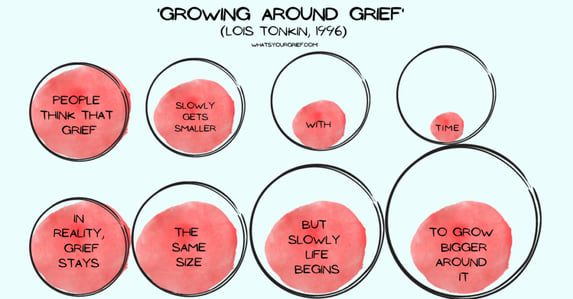Navigating Grief: Debunking 10 Common Myths About the Healing Journey
Grief is incredibly painful. It’s something no one should have to go through, and yet everyone will experience it at some point. If you’ve lost someone or something you love, you’re not alone and we’re here to support you.
Part of our support is addressing myths. Because, unfortunately, we know there are many misconceptions swirling around about grief. Grief is hard enough on its own without all of the misconceptions making you feel guilty or worse, leaving you second guessing or not knowing what’s true.
So, in this post, we want to shed light on the following 10 myths—exposing the lies and offering up the truth to help you when you’re grieving:
- Grief has an endpoint
- You can only grieve a death
- Grief is linear
- The goal of grief is to find closure
- The pain will go away if you ignore it (or numb it)
- If you still ___, it means you’re stuck
- What works for someone else will work for you (and vice versa)
- Once you get through the “firsts”, they get easier
- Faith makes grieving easier
- Moving on means you’re forgetting
Myth #1: Grief Has an Endpoint
People tend to think there is an endpoint when it comes to grief, that those grieving ‘should’ be done by now (fill in whatever specific time frame). The problem is this leaves those who’ve experienced loss often feeling guilty for continuing to grieve or struggling to cope with the loss.
The truth is, there is no endpoint. There’s no ‘magic’ spot to strive towards where everything will suddenly be okay. It doesn't matter how long you knew someone, whether the loss was sudden or prolonged, how your life is currently going…grief is likely going to continue indefinitely. But that’s not necessarily a bad thing! It shows that you loved someone or something deeply, that you cared, and that you’re carrying a part of it around with you.
The diagram below helps show how grief may be with you forever, but that doesn’t mean the rest of your life is forever consumed by it. Grief can persist indefinitely, but that doesn't mean life can't move forward alongside it.

Myth #2: You Can Only Grieve a Death
While grief may be most commonly referred to regarding the death of a person or pet, it’s not the only loss that needs to be grieved. A misconception is that grief = death, when in reality it’s grief = loss.
We want you to know that grief is valid for any loss, not just the death of someone. Other things you can grieve include, but are not limited to:
- Loss of a job
- Breakup or loss of a friendship
- Life transition (new career, moving to new state, empty nesters, etc.)
- Injury or illness
- Mental health struggles
- Infertility
- Loss of hopes and dreams, or the life you thought you would have
Don’t let anyone tell you your grief is invalid just because someone didn’t die. You’re still mourning a change or the loss of something important, and your experience is valid.
Myth #3: Grief is Linear
Even though there is no endpoint to grief, some people still think that grief is linear. In other words, there are clear, easy steps people take to get better over time. Aka the 5 stages of grief.
The popular 5 stages of grief model—denial, anger, bargaining, depression, acceptance—are oftentimes inaccurate. This is not to say if you’ve experienced any or all of these stages that your experience is invalid. We’re just stating that this model, while trying to do good by gaining an understanding of grief, is simply a theory and cannot generally represent your or anyone else’s experiences. Oftentimes, these 5 stages make you guilty for where you “should” be or attempt to neatly pack grief away into stages or boxes. As much as we’d love that, grief is not that simple.
While those who’ve experienced loss do get better over time, it’s far from linear. It’s very much up and down with a general trend of improving with time. But just because you’ve been getting better or feeling better doesn't mean bad days or seasons won’t suddenly pop up. And that’s totally okay and normal.
Myth #4: The Goal of Grief is to Find Closure
Remember how earlier we said grief has no endpoint? Well, closure presumes there is an endpoint and that “closure” is it. As if it’s something that’s waiting for you at the finish line of grief. Closure tells us that our grief can be wrapped up nicely with a bow so that we can move on. But grief simply will never be that way.
Now, that doesn’t mean that you can’t or won’t ever move forward after grieving. Or that you’re going to be miserable and heartbroken forever. What happens is over time you learn to carry the grief with you in healthy and purposeful ways. You use it to connect you to the person or thing you loved and lost while still moving forward into whatever life has next for you.
Myth #5: The Pain Will Go Away If You Ignore It (or Numb It)
This myth is well-meaning, and is often your brain's way of doing its best to protect you from the pain here and now. It thinks that if you just ignore the pain, just “be strong”, that it will go away quicker. What this really does, though, is push the pain and everything else down so that when it all inevitably comes back up (and yes, it will), it’s an even bigger explosion. Like a volcano exploding all at once rather than letting out a little at a time.
Numbing also does something very similar. Whatever you use to numb yourself—food, alcohol, drugs, tv, social media, sex—provides temporary relief but does nothing to help you work through your pain and feelings. So, whenever you stop using your numbing mechanism, all the pain floods right back in and you’re left needing to numb out even more than before. It’s a vicious, never ending cycle.
Instead of trying to ignore or numb your pain, let it out! Scream, cry, punch a pillow, journal, call a friend, go for a run, sit in silence, reminisce on good memories—anything that allows you to feel and process. Because facing, accepting, and dealing with your feelings in a healthy manner helps you continue to heal. The pain may never go away fully, but the amount will decrease over time because you’re letting it out rather than pushing it down.
Myth #6: If You Still ___, It Means You’re Stuck
There’s often a pressure to remove photos, get rid of belongings, stop talking about what you lost, stop crying whenever you think about it, etc. after a certain amount of time. Otherwise, you’re stuck and have not moved on. But that’s not true at all.
You wouldn’t criticize someone for holding onto something special from their childhood. You wouldn’t tell that person that they still think they’re a child and haven’t moved into adulthood. So, why do we tell people who grieve essentially the same thing?
The truth is, keeping mementos or talking about the loss doesn't mean you're stuck—it's a personal choice. Some people may want things gone right away, some take a little more time, and some may never be ready to remove belongings or stop talking about what they lost. That’s okay. Grieve the way that you need to, not anyone else’s timeline or way.
Myth #7: What Works for Someone Else Will Work for You (and Vice Versa)
People get this wrong for a lot of different struggles (relationship issues, physical or mental health, etc.) but especially for loss and grief. When someone assumes that what worked for them has to work for someone else (or vice versa), there tends to be a lot of shame and sadness around the person who it didn’t work for. That person may assume they’re doing things ‘wrong’ or grieving the ‘wrong’ way. As if there is a ‘right' way.
As we’ve mentioned before, the grieving process is so different for every single person. Because every single person is different. What worked for Sally down the street might not work for you, and that’s okay. What worked for you might not be a great fit for your coworker Bob, and that’s okay too.
It’s not inherently bad to give advice if it’s requested or to receive suggestions from others should you want it. So long as you understand that it might not work, and that’s okay and normal. The goal of grieving isn’t to do what everyone else is doing; it’s to find what works for you, allowing you to cope in healthy ways and move forward in life on your own time.
Myth #8: Once You Get Through the “Firsts”, They Get Easier
Ah, the firsts—first anniversary or first birthday without them, first Mother’s or Father’s Day without a parent, the first anniversary of the loss. Yes, those will likely be the most difficult because it’s still so fresh.
But the idea that the second anniversary or heck the 22nd anniversary will be easier and not still painful, is false. It could be less painful. Or, it could be just the same or sometimes even more painful depending on what else might be going on.
So, don’t go into each year or date thinking this ‘should’ be easier. Allow yourself to feel and grieve each time the calendar comes back around to a certain day or date. You’re in a different place each year and your pain is valid.
Myth #9: Faith Makes Grieving Easier
We connect people to local churches and ministries, and we believe that faith can be an important factor of someone’s grieving process. However, sometimes faith complicates grief, especially if people use well-meaning, but often hurtful, platitudes such as ‘he’s in a better place’ or ‘it’s all part of God’s plan’.
While these phrases are usually meant to bring comfort to the griever, they can often make the person grieving feel as if the depth of their pain is somehow reflective of their faith. This can cause believers to question their faith if they’re grieving a loss that was part of God’s plan or wonder why they're still feeling the pain of grief when someone they love is now with God.
While faith can certainly help people find hope, peace, or comfort after experiencing a loss, it doesn’t guarantee that pain won’t be there or that grieving will be easier. If you’re interested in reading more about the relationship between grief and belief, here is a great article.
Myth #10: Moving On Means You’re Forgetting
So, let’s get this straight. Those who have experienced loss get shamed for not moving on quickly enough (see myth #1 or #6)...yet also get shamed for moving on period. Make it make sense.
Let’s get straight to the point: moving on in any capacity does NOT mean you're forgetting the thing(s) you lost. The goal of grieving is to move on with your life. Not forgetting or letting go of the person or thing you lost, but rather accepting the loss and letting go of the way the pain controls you. The goal is to find a way to move through life and take any grief along with you wherever your new journey takes you. So…..
- Starting to date again after losing a spouse does not mean you’re forgetting your spouse or the previous love you shared.
- Getting pregnant or adopting after a miscarriage does not mean you’re vowing to ignore the child you previously lost.
- Noticing you’re doing better or not crying when you think about someone or something you lost doesn’t mean you’re erasing them from your memory.
It’s also important to remember that there is no timeline for your grief and pain. You can still feel the pain and move forward if you want. Some people might move on in 2 years and it may take you 12 (or vice versa). You are the only one who can know when you’re ready to move forward and make that decision for yourself.
Wrapping Up
Wrapping up, there are obviously many more myths than these. But, we hope the way we’ve addressed these 10 helps you feel seen, heard, understood, and, most importantly, lets you know that grieving is completely normal and okay. Everyone’s grief journey is unique, and there is no right or wrong way to grieve.
We hope you also know that you don’t have to go through a loss or learn to cope with one on your own. We’re here to support you and help you out along the way as you learn to move through life and take grief along with you wherever your new journey takes you.
So, take your time, do what you need to do for yourself, and seek support when you need it. You are never alone.




